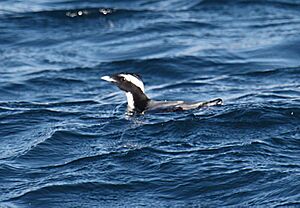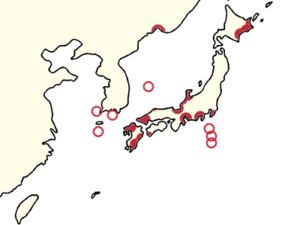Japanese murrelet facts for kids
Quick facts for kids Japanese murrelet |
|
|---|---|
 |
|
| Conservation status | |
| Scientific classification | |
| Genus: |
Synthliboramphus
|
| Species: |
wumizusume
|
 |
|
| Synonyms | |
|
Uria wumizusume (protonym) |
|
The Japanese murrelet (Synthliboramphus wumizusume) is a small seabird that lives in the ocean. It's part of the auk family, like puffins. These birds are found near the rocky coasts of Japan and sometimes near South Korea and Sakhalin. They are quite rare, with only about 2,500 to 10,000 birds left in 2017. This makes them one of the most endangered auks.
Contents
How the Japanese Murrelet Got Its Name
The Japanese murrelet is a unique species, meaning it's the only one of its kind in its group. A scientist named Coenraad Jacob Temminck first described it in 1836. He called it Uria wumizusume.
Later, in 1837, another scientist, Johann Friedrich von Brandt, created a new group for it called Synthliboramphus. He gave it a new name, temminckii. However, the first name given by Temminck, wumizusume, is the one that stuck. This is because of a rule in science called the "Principle of Priority," which means the first valid name given to a species is usually the correct one.
In Japan, this bird is called kanmuri-umisuzume, which means "crested sea sparrow." It's similar to the Ancient murrelet (Synthliboramphus antiquus), but you can tell them apart by the Japanese murrelet's black crest.
What the Japanese Murrelet Looks Like
The Japanese murrelet is a small seabird, about 24 to 26 centimeters (9 to 10 inches) long. Its wingspan is about 43 centimeters (17 inches), and it weighs around 164 to 183 grams (5.8 to 6.5 ounces).
Its back and upper parts are blackish and bluish-grey. Its throat and belly are white. Its legs and feet are yellowish-grey, and its short, thick beak is bluish-grey with a darker top. Its eyes are dark brown.
On its black head, it has a white stripe that goes from above each eye and meets at the back of its neck. This stripe is harder to see in winter. In summer, it has a special crest of black feathers that are 3 to 5 centimeters (1 to 2 inches) long. This crest helps tell it apart from the Ancient murrelet. Young birds look like adults in winter, but their heads and backs are a bit browner.
Sounds of the Japanese Murrelet
These birds make different sounds. When flying, they might make a quiet "ch-ch-chi-chi" or "peee-p-p-p." When they are at their nest, they can make sounds like "jee-jujjujju" or "jijiji-pipewpipewkukukuku."
Where the Japanese Murrelet Lives
The Japanese murrelet lives in the cool and warm waters of the northwest Pacific Ocean. It breeds on small, rocky islands and coasts in Japan. These areas stretch from Nanatsujima in Ishikawa Prefecture in the north to Tori-shima in the Izu Islands to the south.
Some of the main breeding spots include Birōjima in Miyazaki Prefecture and the Izu Islands. They also breed on other small islands like Mimiana Island and Kōshima. After breeding, they spread out along Honshū and Kyūshū, following warm ocean currents. They have been seen as far north as Sakhalin and as far west as South Korea and Taiwan. Around December, they fly back to the waters near their breeding locations for the winter.
Life and Habits of the Japanese Murrelet
What the Japanese Murrelet Eats
The Japanese murrelet mainly eats small sea creatures. Their diet includes krill and other tiny crustaceans that float in the water. They also eat small shrimp and young, small fish. Some of the fish they eat are Pacific herring, sculpin, smelt, sand eels, and sandlances.
Reproduction and Life Cycle
These birds build their nests in rocky cracks and hollows. They also use gaps between piles of stones or among grasses on islands where no people live.
Usually, the female lays two eggs, about a week apart. This happens from late March to early April. On Tori-shima, which is further south, they lay eggs a little earlier. Both parents take turns incubating the eggs for about a month.
The chicks are born ready to move around and don't get fed in the nest. Instead, they leave the nest with their parents on the second night after hatching.
Protecting the Japanese Murrelet
The Japanese murrelet is listed as a Vulnerable species by the International Union for Conservation of Nature (IUCN). This means it is at high risk of becoming endangered.
Threats to the Murrelet
Many things threaten these birds:
- Fishing Nets: They often get caught by accident in large fishing nets used by commercial fishing boats.
- Human Activity: People fishing for fun can disturb the birds and leave waste that attracts animals that might prey on the murrelets.
- Predators: Animals like rats, wild cats, large-billed crows, and black-tailed gulls hunt the murrelets and their eggs.
- Pollution: Oil spills and other pollution in the ocean are also a danger.
- Past Hunting: In the past, people collected adult birds and their eggs, which greatly reduced their numbers.
- Historical Events: In the 1950s, the Ōnohara Islands, a key nesting site, were used for military training. This caused significant harm to the bird population there.
Conservation Efforts
The Japanese murrelet is protected by law in Japan. In 1975, it was named a Natural Monument. This gives it special protection under Japanese cultural property laws. In 2009, the Wild Bird Society of Japan chose the Japanese murrelet as a symbol for protecting marine life.
Other countries also recognize the bird's vulnerable status:
- In China, it is listed as "Data Deficient," meaning there isn't enough information yet.
- In Taiwan, it's "Not Applicable" because very few birds visit there.
- In Russia (Sakhalin and Khabarovsk Krai), it's listed in Category 1, meaning it's very rare and at high risk.
- In Korea, it's listed as Endangered, with some breeding on offshore islands.
- Japan's Ministry of the Environment has consistently listed it as Vulnerable on its Red List since 1991. Some prefectures, like Mie, also list it as a Prefectural Endangered Species.



